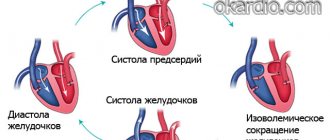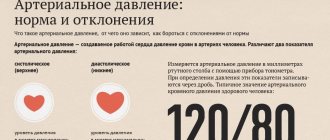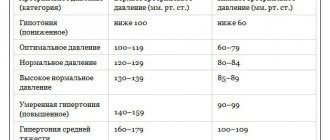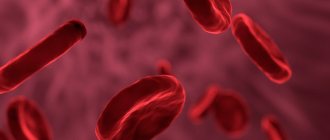Author:
Amelicheva Alena Aleksandrovna medical editor
High blood pressure (arterial hypertension, hypertension) is a persistent increase in systolic blood pressure above 130 mmHg and/or diastolic blood pressure above 90 mmHg.
Blood pressure is the force of blood pressure on the walls of the arteries. High blood pressure is more than normal pressure from the blood against the walls of the arteries.
Causes of high blood pressure
High blood pressure is divided into 2 types:
- primary (essential) hypertension (or hypertension) is the most common type of high blood pressure, often has no cause, develops over many years, the risk increases with age;
- secondary hypertension occurs against the background of the development of any disease (kidneys, endocrine system organs, sleep apnea) or taking certain medications.
Causes of high blood pressure include:
- old age (the older a person is, the higher the likelihood of developing hypertension);
- family history of the disease (high blood pressure in parents or other close relatives);
- unhealthy diet - diet high in salt and fat;
- lack of physical activity;
- overweight, obesity;
- sleep disorders;
- chronic diseases (chronic kidney disease, endocrine disorders, diabetes, high cholesterol);
- race (eg, African Americans have a higher risk);
- gender (in middle age, high blood pressure develops more often in men, in old age - in women; women who had high blood pressure during pregnancy are more prone to arterial hypertension in old age);
- certain medications (contraceptives, decongestants, NSAIDs, antidepressants);
- stress;
- smoking;
- alcohol abuse;
- non-compliance with sleep schedule, night shift work.
High blood pressure is often called the “silent killer” due to its lack of noticeable symptoms. In some cases (especially when blood pressure levels reach dangerously high levels), a person may complain of headache, nosebleeds, and shortness of breath. Many people do not associate these symptoms with abnormal blood pressure readings because they are not in the habit of periodically monitoring their blood pressure with a doctor or at home.
Diet is an important factor in the fight against high blood pressure
A healthy lifestyle can work wonders. Some reduction in systolic (upper reading) blood pressure can be achieved by increasing physical activity, losing excess weight, and changing your eating strategy.
- Sodium, which is the main component of table salt, negatively affects kidney function and contributes to an increase in diastolic (lower) pressure. Therefore, limiting salt to 5 grams daily helps normalize the levels. Try to gradually replace NaCl with spices and herbs that have a beneficial effect on the body. They promote the removal of toxins and suppress the growth of pathogenic microflora.
- Hypertensive patients with extra pounds are advised to limit the consumption of fats, smoked and fried foods, and easily digestible hydrocarbons (sweets, potatoes, etc.).
- Food should be taken several times a day in small portions, without overeating and giving preference to lean meat and fish, cereals, low-fat fermented milk products, vegetable and low-fat meat soups, fresh vegetables and fruits.
- Products with a high content of potassium and magnesium will be extremely useful - fresh apricots, dried apricots, apples, etc.
- It is very important to limit the consumption of alcohol, which reduces the effectiveness of antihypertensive drugs.
- The effect of caffeine on blood pressure has not been fully studied. But it is known that an increase in blood pressure by 5-10 points after a cup of coffee may indicate high sensitivity to caffeine. Therefore, you should not abuse the aromatic drink.
Blood pressure readings
- Normal pressure is from 90/60 mm Hg. Art. up to <120/80 mmHg Art.
- Prehypertension (risk factor for the development of arterial hypertension) - 120–129 mm Hg. Art. / <80 mmHg Art.
- Arterial hypertension 1st degree - 130–139 mm Hg. Art. or 80–89 mm Hg. Art.
- Arterial hypertension 2 degrees - ≥140 mm Hg. Art. or ≥90 mm Hg. Art.*
*American Heart Association classification.
Online blood pressure calculator on the NHS website.
American College of Cardiology online cardiovascular risk (stroke, heart attack and other diseases) calculator (risk of complications for patients with high blood pressure over the next 10 years and beyond).
Upper, lower, pulse pressure
The upper, systolic, cardiac pressure indicates the work of the heart at the moment of pushing out blood. An increase in the upper indicator is accompanied by a rapid pulse, discomfort in the chest area, and shortness of breath. High systolic pressure accelerates wear and tear of the heart and leads to structural changes in the myocardium. Long-term hypertension may develop:
- Coronary heart disease is a decrease in blood circulation in myocardial tissues.
- Heart failure is incomplete filling and emptying of the ventricles.
- Infarction is the formation of a necrotic focus in the myocardium.
- Left ventricular myocardial hypertrophy is the growth and thickening of muscle tissue, which leads to impaired contractile function, up to sudden cardiac arrest.
Lower, diastolic, renal pressure depends on the condition of the blood vessels. Manifestations of high diastolic pressure are muscle weakness, visual disturbances, and dizziness. Also, the need to control blood pressure is indicated by kidney disease, swelling, difficult diuresis during the day and excessive urination at night.
Consequences of hypertension with high renal pressure:
- Stroke is an acute disorder of cerebral circulation, which may be accompanied by hemorrhage.
- Renal failure - due to tissue nutritional disturbances, the kidneys cannot work normally, intoxication begins with damage to all organs and systems.
- Deterioration in the elasticity of blood vessels - fragility, microhemorrhages, and hematomas appear on the skin.
- Malnutrition of the limbs - peripheral blood circulation is hampered with the possible formation of ulcers and the development of gangrene.
Also important is the difference between the upper and lower indicators - pulse pressure. Normally it is 30-50 mmHg. When it decreases, lethargy occurs, throbbing headaches in the frontal and occipital regions, cognitive function is impaired, and the ability to concentrate decreases. A decrease in the indicator may occur due to:
- Atherosclerosis, aortic aneurysm.
- Kidney nutritional disorders.
- Aneurysms with different localizations, including cerebral vessels.
- Inflammation of the serous membrane of the heart.
- Hemorrhages.
With increased pulse pressure, the myocardium regulates blood circulation with great tension, which provokes disturbances in the functioning of the heart, characteristic of high systolic pressure.
How often should you check your blood pressure readings?
Blood pressure is usually measured when visiting a doctor (for example, a therapist). There is no need to specifically visit a specialist for this; it is enough to ensure that the pressure is measured at least once every 2 to 5 years, starting from the age of 18 (with normal blood pressure and no increased risk of cardiovascular diseases).
People over 40 years of age, and people 18–40 years of age at risk of high blood pressure, should have their blood pressure checked at a healthcare facility at least once a year. If a diagnosis of arterial hypertension has been established or a person has other risk factors for developing cardiovascular diseases, it is recommended to measure blood pressure more often and not neglect monitoring at home. Your doctor will help you choose a device for measuring blood pressure (tonometer).
For children 3 years of age and older, blood pressure is measured regularly during annual routine examinations.
Caution: The American Heart Association does not recommend the use of wrist- or finger-worn blood pressure monitors, which are less accurate.
If recommended, measure blood pressure at home twice a day on the left and right arm: in the morning before breakfast (but not immediately after waking up) and before taking any medications, and in the evening, preferably at the same time. In each case, you need to measure the pressure 2-3 times (at short intervals, 1-3 minutes) for a confident, accurate result. 30 minutes before, do not smoke, do not eat, do not drink coffee (and alcohol), do not exercise, and empty your bladder. During the measurement, you must sit in a comfortable position, leaning back in a chair or armchair, do not cross your legs and ankles, and do not talk. The arm on which the cuff is worn must be freed from clothing and held at heart level; it is most convenient to place it on a table or armrest of a chair. Don't forget to write down your measurement results.
Normal diastolic pressure
The approximate limits of normal diastolic pressure indicators in patients of different ages are identified. It should be taken into account that fluctuations in these values are also largely due to the individual characteristics of the patient’s body. Rare small deviations from the norm may not be a cause for concern, but pronounced diastolic hypertension indicates developing pathologies.
Diastolic pressure indicators
| Patient age | Lower limit of normal | Upper limit of normal | Pathological indicators |
| 15-16 | 51 | 79 | 50 or less, 80 or more |
| 17-29 | 61 | 84 | 60 and less, 85 and more |
| 30-39 | 61 | 89 | 60 and less, 90 and more |
| 40-59 | 61 | 89 | 60 and less, 90 and more |
| 60-69 | 61 | 89 | 60 and less, 90 and more |
| Over 70 | 89 | 65 and less, 90 and more |
Attention!
If a person's blood pressure is regularly higher than normal, the specialist defines this condition as hypertension. This disease can lead to the development of various complications that significantly reduce the patient’s quality of life.
Is it possible to normalize high blood pressure and what to do?
Yes, with the help of lifestyle modification (influencing modifiable factors), treating the underlying disease, taking medications that normalize blood pressure.
Lifestyle modifications include proper nutrition, including avoiding fatty foods and reducing salt intake (the DASH (Dietary Approaches to Stop Hypertension) eating plan recommended by the US National Heart, Lung, and Blood Institute is preferred); weight normalization; quitting smoking and alcohol; regular physical activity; stress management (for example, mastering relaxation techniques).
If you have persistently high blood pressure due to a medical condition (such as diabetes) or caused by taking certain medications, it is recommended that you consult your doctor. Control of the underlying disease, refusal of drugs (or their replacement) that increase blood pressure, make it possible to stabilize the patient’s blood pressure and condition.
Nonmodifiable risk factors associated with high blood pressure include age and family history.
Brief conclusions
- The causes of high blood pressure can be either humoral (tension of the vascular walls under the influence of biologically active substances) or neurogenic (hyperactivation of the sympathetic nervous system).
- Blood pressure can rise due to a number of factors, such as stress, tension, overwork, and physical activity.
- High blood pressure can also be caused by a specific disease (example: kidney disease, brain tumors, hypo- and hyperthyroidism, taking corticosteroid hormones).
- In children, high blood pressure often develops under the influence of psycho-emotional stress.
Treatment of high blood pressure
Treatment of arterial hypertension is based on lifestyle modification, constant monitoring of blood pressure, and the use of antihypertensive drugs (medicines that lower blood pressure) - one or more, based on the patient's individual situation.
Medicines prescribed for high blood pressure include: ACE inhibitors, angiotensin II receptor inhibitors, calcium channel blockers, diuretics, beta blockers, alpha blockers, alpha beta blockers. In most cases, these medications do not cause side effects. However, you should not self-medicate; you should consult a doctor who will select an effective drug and prescribe a regimen for its administration. It is important to follow all recommendations, observe the dosage and not skip taking the drug(s).
When diagnosing arterial hypertension, 24-hour blood pressure monitoring (ABPM) provides an accurate idea of the patient’s blood pressure levels. ABPM also excludes the factor of chance, distortion of real blood pressure readings (the so-called “white coat” syndrome or “white coat” hypertension), and registers imperceptible changes in blood pressure (for example, during sleep). This test is recommended by the American Heart Association to confirm the diagnosis of hypertension.
Can the signs of hypertension be recognized?
The insidiousness of the disease is that it does not make itself felt for a long time. A person with hypertension that has not been diagnosed by a doctor may feel well for quite a long time, while his heart muscle is already working at high pressure.
At the same time, experienced hypertensive patients can easily name the signs that accompany increased blood pressure. Experts do not call them symptoms of the disease, because, strictly speaking, they do not signal an increase in blood pressure, but a complicated course of the disease.
- The patient's vision deteriorates, headaches, and tinnitus occur.
- Decreased strength and sensation in one or both limbs.
- At rest, shortness of breath and dizziness occur.
- The daily urine output inexplicably decreases.
In case of undiagnosed hypertension of II and III degrees or when stopping taking antihypertensive, blood pressure-lowering drugs prescribed by a doctor, the patient may experience a hypertensive crisis, sharply exacerbating the symptoms of the disease. A significant surge in pressure is accompanied by:
- severe headache and chest pain;
- shortness of breath;
- vomiting;
- disturbances of consciousness and convulsions;
- paralysis and even death.
The only way to detect increased pressure is to measure it with specialized devices, tonometers. The gold standard for diagnosing arterial hypertension is 24-hour blood pressure monitoring performed under the patient’s usual conditions. Diagnosis is carried out using a specialized device attached to the body. It measures blood pressure levels day and night at a specified frequency, identifying “daytime” and “nighttime” hypertension. Often, based on the diagnostic results, the patient is prescribed a consultation with a cardiologist.
We use treatment methods such as:
- Manual therapy;
- Osteopathy - treatment by the hands of a doctor, a gentle effect on the musculoskeletal system, nervous and vascular systems, internal organs;
- Medical massage;
- Acupuncture - exposure to biologically active points with microneedles;
- Laser reflexology is a painless effect on reflexogenic zones and points;
- Tsubotherapy is a gentle effect on the body’s reflex points;
- Pharmacopuncture - the introduction of medicinal drugs of natural origin to the source of the problem;
- Plasma therapy is the introduction of the patient’s own purified blood into the site of the disease;
- Isometric kinesiotherapy - individual gymnastic techniques/exercises, according to indications, with elements of joint massage;
- Kinesiotherapy using the Exart installation;
- Kinesio taping;
- Ozone therapy - treatment with active oxygen;
- Physiotherapy;
- Physiotherapy with enzyme preparations;
- Therapeutic droppers;
- Hirudotherapy - treatment with leeches;
- Botulinum therapy is treatment with botulinum toxin preparations.
Ways to lower diastolic pressure
Diastolic hypertension is a condition that can lead to a sharp deterioration in a person’s well-being. Therefore, at the first signs of the development of pathology, it is necessary to take a number of measures aimed at normalizing the functioning of the patient’s body:
- The patient should be placed face down on the couch, and a cold compress or ice pack should be applied to his neck and collar area for 5-10 minutes. This will reduce blood flow tension in the vessels supplying the brain.
- Resort to acupuncture, that is, a procedure for stimulating active points of the body. You need to lightly press on the hollow under your earlobe and move your fingertip to the middle of the collarbone. Repeat the manipulation on the other side of the head.
- Take a cool shower, take a nap. Relieving stress and resting will help lower your blood pressure.
Attention!
All these measures can be used only if the patient feels satisfactorily and does not complain of impaired speech, consciousness, drowsiness or severe dizziness. Otherwise, you should immediately seek emergency medical help.
Drug therapy for diastolic hypertension
Drug treatment for diastolic hypertension should be taken only as prescribed by a specialist. The doctor must take into account the individual health characteristics of the patient, his general well-being, and the presence of chronic or acute diseases. In most cases, the following pharmacological agents are prescribed for the treatment of this pathology:
- Beta blockers: Anaprilin, Atenolol, Metoprolol
and so on. These drugs dilate blood vessels, help to quickly lower blood pressure, and reduce the level of glucose in the blood plasma. These medications are widely used for the treatment of hypertension, but are sold only by prescription. - Angiotensin converting enzymes: Captopril, Enalapril, Quinapril
etc. They are used to treat both systolic and diastolic hypertension. They block the action of an enzyme that causes an increase in blood pressure. - Calcium antagonists: Nifedipine, Verapamil
. These are drugs that are prescribed only for severe hypertension and are used for urgent relief of a hypertensive crisis, that is, to reduce very high blood pressure.
In this case, drug treatment should be comprehensive and long-term. The medications should be taken regularly. Refusal of therapy prescribed by a doctor can lead to a worsening of the condition and the development of persistent hypertension.
from May 14 to 24 as part of the Year of the Heart at the City Hospital No. 1
them. G.I. Drobyshev hosts an informational and practical campaign
“Learn to control your blood pressure.”
One of the most common health complaints and one of the most “favorite” diseases among older people is increased blood pressure. This pathology can explain any changes in well-being, bad mood and other troubles. Blood pressure can rise and fall several times during one day, and a person’s normal blood pressure is a purely individual concept.
What is blood pressure and what indicators are considered normal?
Blood pressure is a general concept that determines the force with which blood presses on the walls of blood vessels; it would be more correct to call it blood pressure, because pressure matters not only in the arteries, but also in the veins and capillaries. But it is only possible to measure pressure in large vessels located on the surface of the body—in the arteries—without the help of special instruments.
Blood pressure - blood pressure - depends on the speed and force with which a person’s heart contracts, how much blood it can pump in one minute, on the properties of the blood itself and the resistance of the walls of blood vessels.
Factors influencing blood pressure:
- the ability of the heart to contract with sufficient force and ensure normal release of blood through the vessels;
- from the rheological properties of the blood - the “thicker” the blood, the more difficult it is to move through the vessels; diseases such as diabetes mellitus, increased coagulability, greatly impede the flow of blood and can lead to problems with blood pressure; with thick blood, some doctors prescribe treatment with leeches;
- elasticity of the walls of blood vessels - blood vessels wear out over time and cannot withstand increased load - this becomes the cause of the development of hypertension in older people,
- atherosclerotic changes - reduce the elasticity of the walls;
- sharp narrowing or dilation of blood vessels - as a result of nervous shocks or hormonal changes, a sharp narrowing or dilation of blood vessels is possible - for example, with fear, anger or other strong emotions;
- diseases of the endocrine glands.
Normal blood pressure is determined by a combination of a large number of parameters, and for each age, gender and for an individual person, its indicators can vary greatly. Medical standards are taken as average values from healthy people of a certain age. It has long been proven that blood pressure of 120/80 cannot and should not be considered the ideal norm for people of different ages.
To find out what normal blood pressure a person should have at different age periods, you can use the following table.
Blood pressure indicators for an adult:
- Normal blood pressure is considered to be between 110\70 and 130\85 mm. rt. Art.
- Low normal pressure – 110\70 – 100\60;
- Low blood pressure – hypotension – below 100\60;
- Increased normal pressure – 130\85-139\89;
- High blood pressure - hypertension - more than 140\90 mm. rt. Art.
Indicators of normal blood pressure for different age periods:
- 16 – 20 years – 100\70 – 120\80 mm. rt. Art.
- 20 – 40 years – 120\70-130\80;
- 40 -60 – up to 140\90;
- over 60 years old – up to 150\90 mm. rt. Art.
From the table above, it is clear that the older a person is, the higher the normal blood pressure indicators; this is due to age-related changes in blood vessels, in the heart muscle and in other organs. High blood pressure, like low blood pressure, can cause various health problems, but in order to determine whether changes in blood pressure are to blame for poor health, you need to measure it regularly and keep a special diary. For this, several trips to the clinic or visits to the doctor are not enough; only daily regular blood pressure measurements can give correct results.
Measurement.
The correct diagnosis and prescription of treatment largely depends on the correct measurement of blood pressure, because the doctor, when prescribing medicine or prescribing treatment, is largely guided by the measurement numbers.
Today there are different ways to measure pressure:
- The simplest and oldest - using a cuff and a tonometer - here it is of great importance to correctly apply the cuff, the ability to use a tonometer and listen to heart sounds. This measurement requires special training and skills, but when used correctly, it gives fairly accurate and reliable results.
- Electrotonometer - the operating principle is the same, but the results are visible on a special display. This makes it easier to measure your blood pressure yourself and provides more accurate results. But such blood pressure monitors often break down and may show incorrect numbers.
Regardless of the method used to measure blood pressure, several general rules must be followed:
- before the measurement, half an hour before the start, avoid physical activity, nervous tension, smoking, eating, and so on,
- relax, sit comfortably when measuring,
- the posture should be comfortable, the back should be straight, there must be support, the hand should rest freely at the level of the patient’s chest,
- you cannot talk or move during the measurement,
- The measurement should be carried out on both hands and it is advisable to carry out a series of measurements with an interval of 5-10 minutes.
If, after correctly measuring blood pressure, the readings are very different from the norm, you need to repeat the measurements within a few days and, if confirmed, consult a doctor.
High blood pressure.
Considered one of the most dangerous diseases of mankind, hypertension affects about 25% of people worldwide, and this figure continues to increase. Hypertension is an increase in blood pressure above 140/90 mmHg. rt. Art. Causes of hypertension can be:
- overweight,
- genetic predisposition,
- diseases of internal organs,
- lack of physical activity,
- smoking and drinking alcohol,
- excessive consumption of table salt,
- nervous tension,
- other factors.
With hypertension, the patient suffers from headaches (and here pills for headaches will not help), shortness of breath, heart pain, increased fatigue, insomnia, poor health and other symptoms. In addition, the risk of developing cardiovascular diseases, brain damage, pathology of the urinary system and eye diseases increases.
Treatment of hypertension is a very complex and time-consuming process, where the outcome of the disease depends on compliance with the doctor’s recommendations. It is important to find the cause of the increase in pressure and act on it. At the same time providing symptomatic treatment. In each specific case, medications, doses and their combinations must be selected individually by the attending physician.
Without timely treatment or uncontrolled use of medications, hypertension can not only seriously damage health, but also cause a life-threatening condition such as hypertensive crisis.
Hypertensive crisis.
Hypertensive crisis is a life-threatening condition caused by a sharp increase in blood pressure and damage to the nervous system and target organs. Blood pressure figures during a hypertensive crisis can vary greatly in different patients - some people normally tolerate 200\150 mm. rt. st, and for some people feel bad already at 150\85 mm. rt. Art. The nature of the lesions in GC depends on which organs previously had the pathology - if the heart hurts, myocardial infarction may occur, if you suffer from headaches, then a stroke, and so on.
The causes of GC may be:
- psycho-emotional stress,
- exercise stress,
- meteorological changes,
- drinking alcohol,
- rich foods high in salt,
- incorrectly selected antihypertensive drugs,
- diseases of the endocrine system and internal organs.
With the development of GC, the patient’s well-being sharply worsens, a feeling of fear and anxiety arises, nausea, vomiting, darkness before the eyes, swelling and flushing of the face, chills, tremors of the limbs, fainting, and even coma may appear.
If such symptoms appear, you need to lay the patient on any flat surface with the head of the bed raised and immediately call an ambulance. Before her arrival, try to provide the patient with peace, an influx of fresh air, and get rid of restrictive clothing. If the patient has had hypertension for a long time, then, most likely, he is taking some kind of antihypertensive drug, in this case, before the doctor arrives, you can give the patient the usual dosage.
Hypotension, low blood pressure.
For many people, especially those suffering from hypertension, it seems that lowering blood pressure cannot be a problem, but in fact this is not the case. Constantly low blood pressure can cause no less inconvenience and health problems than hypertension.
The causes of this pathology can be hereditary predisposition, poor nutrition and vitamin deficiency, endocrine diseases, nervous strain, general exhaustion of the body and other problems.
A person suffering from hypotension constantly feels tired, overwhelmed, has difficulty performing daily duties and is emotionally inhibited. In addition, there is a decrease in memory and brain activity, poor thermoregulation, increased sweating, headaches, drowsiness, pain in the joints and muscles, and a general feeling of poor health.
Although, unlike hypertension, hypotension does not cause serious health problems, it also requires treatment. Only a doctor can determine the cause of hypotension and prescribe treatment after a detailed examination. And without medical help, we can advise you to establish a work and rest schedule, eat well, not be nervous and give up bad habits.
Original article https://tibet-medicine.ru/sovrmed/normalnoe-davlenie-cheloveka
What does the forecast depend on?
It is possible to predict how effectively it will be possible to treat high lower blood pressure:
- If this is new or periodic diastolic hypertension in young people (up to 40 years of age), in the absence of serious illnesses, it is treated by taking medications (if necessary) and it does not lead to dangerous consequences.
- Constant hypertension at the lower level for more than 5–10 years in people over 45–50 years old leads to complications in 80% of cases.
- If an increase in lower pressure is combined with systolic hypertension, the risk of myocardial infarction, stroke and cerebral hemorrhages, dissection of aortic aneurysms increases tenfold.
When measuring blood pressure, do not forget to record the lower (diastolic) reading. Don’t forget to tell your doctor these numbers - that your lower blood pressure is high - a lot can depend on them!











